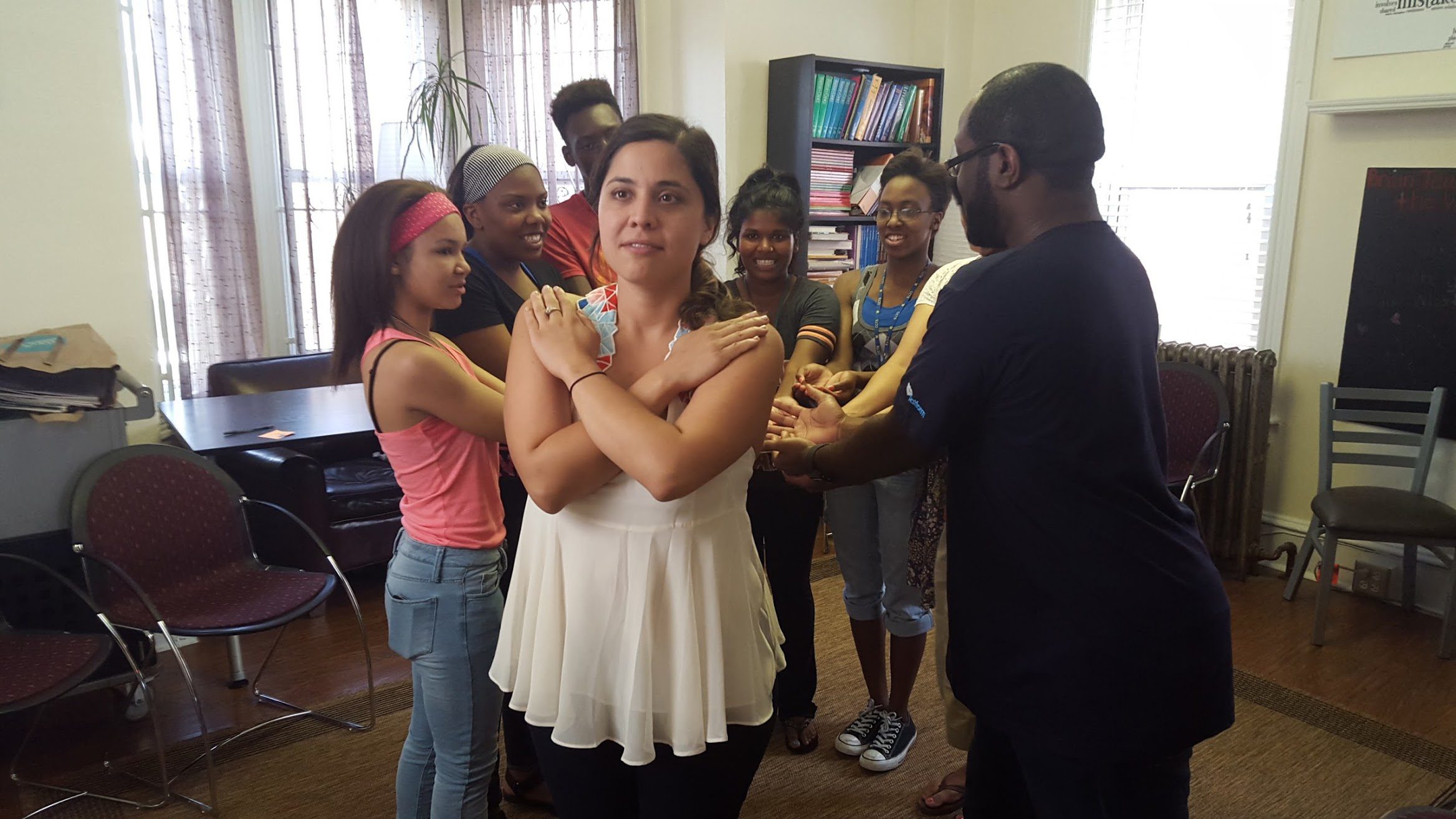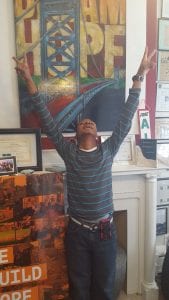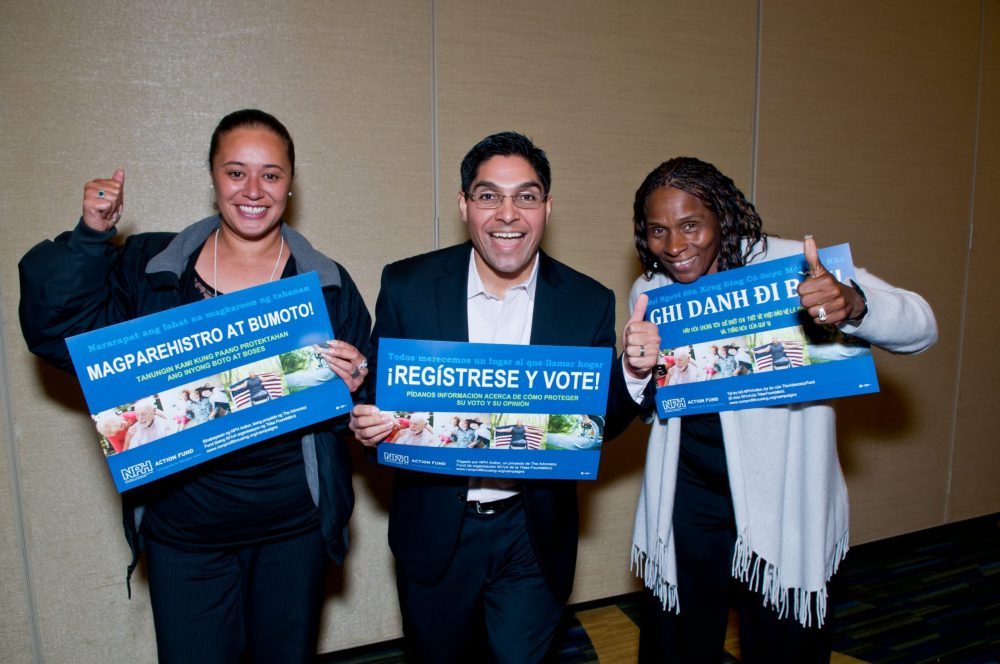
Members of the Hopeworks Food Advocacy group prepare for a project by learning to trust each other. Photo courtesy of Hopeworks ‘N Camden
At a workforce training and education center for 14- to 24-year-olds called Hopeworks ‘N Camden, it used to be that “when a youth disappointed us, perhaps if they showed up late, we would set boundaries, say they were unmotivated, and talk about the deficits—all the things ‘wrong’ with the young person,” says the program’s executive director, Dan Rhoton. But then the organization was reworked from top to bottom to take into account the effects of trauma, which most participants (and many employees) have experienced. Operating through “trauma-informed” practices has been a game changer, says Rhoton. “Now we explore what is happening, which leads to much more productive conversations, and more successful results.”
Camden and Hopeworks
Like many other post-industrial cities in the Northeast and Midwest, Camden, New Jersey, transformed from a thriving manufacturing city in the 1950s to a city in severe economic distress. Located across the Delaware River from Philadelphia, Camden experienced decades of disinvestment and general neglect that left residents with crumbling infrastructure and fewer social and economic opportunities than in surrounding suburbs. Nearly half of its residents, most of whom are Black and Hispanic, live at or below the federal poverty line.
Though the city has stable and thriving higher education and health care sectors, the Campbell Soup Company’s headquarters, and a newly relocated Subaru headquarters, many residents lack real educational or training opportunities to participate in the regional skilled workforce. Many also reach their teenage years having experienced different kinds of trauma related to poverty—homelessness, dropping out of high school, and high crime and incarceration rates—all of which affects physical and mental health.
Housed in a small row home in the heart of north Camden, Hopeworks ‘N Camden is a bustle of activity from morning to evening. The organization functions as a workforce training center, student housing program, and education center for youth. Its curriculum covers professional, emotional, and life development, teaching hard and soft skills.
Stress and Its Effects
At Hopeworks ‘N Camden, participating youth have often experienced a lifetime of traumatic events and toxic stress, two things that are common in a life lived below the poverty level. When children are exposed to toxic or traumatic stress, their emotional, mental, and physical development suffer. Prolonged and intensive activation of the body’s stress response through ongoing exposure to violence, caregiver neglect, the imprisonment of a family member, exposure to community violence, or physical or sexual abuse can actually change a child’s brain development and structure.
An organization dealing in care work is also affected by trauma and toxic stress. As these organizations experience limited resources and complex work environments, chronic stressors often inhibit their ability to meet the needs of their clients. Picture an overworked staff with limited resources trying to help a group of youth earn their GEDs. Now imagine that these youths may not have a safe place to go to at night, or maybe they just lost a family member to violence. Despite the emotional and logistical upheaval of such circumstances, staff and youth are still obligated to meet deadlines. Staff is burnt out, youth feel overwhelmed, and leadership is stretched thin. As a result, an atmosphere of toxic stress develops.
Trust between staff and leadership becomes eroded when the lack of resources causes ongoing emergencies. This state of constant crisis makes emotional management difficult. As a result, the organization fails to learn from its mistakes, even as service delivery becomes increasingly ineffective. Unresolved conflict and miscommunication become the norm. In turn, leadership becomes controlling, even authoritarian and punitive. Finally, program standards are lowered and full burnout sets in. In the end, the organization’s mission goes unmet.

Chris Tooley completes training at Hopeworks earning a job in web design. Photo courtesy of Hopeworks ‘N Camden
Recreating Sanctuary: The Values and Toolkit
Developed by Dr. Sandra Bloom at Drexel University, the Sanctuary Model is a set of values and practices that a care work organization can adopt to break this cycle. The model creates an environment where youth and staff can realize how their own traumatic experiences have shaped how they function in the workplace. Because people who experience childhood trauma and toxic stress often fail to develop the ability to grieve and accept loss, they may be resistant, or maladaptive, to change as an adult. The model facilitates learning to help people react appropriately and accept the challenges of new workplace environments, relationships, and duties.
Recognizing the parallel process between stressed organizations and the traumatized individuals they serve, The Sanctuary Model serves as an alternative organizational culture that is able to confront the outcomes of childhood trauma and organizational stress. Fundamentally, it does exactly what it sounds like: it creates a sanctuary, a safe environment where one is able to relearn attachment. “When I first got here it was really interesting,” says one participant. “It was different than I was used to: it was welcoming, very, very welcoming, which actually made me uncomfortable, and I wasn’t really used to that. You come here to work and do the training, but everyone is so happy.”
The Sanctuary Model has seven fundamental commitments that are formulated to counter the individual and organizational stresses directly:
- Nonviolence responds to the hyper arousal and lack of safety and trust in traumatized individuals and organizations. According to Rhoton, we often define violence too narrowly. “In fact, many nonprofits, particularly those serving youth, use violence, threats, and coercion to achieve their goals,” he says. “When a young person is threatened with being ejected, losing opportunity, or being incarcerated if they do not comply, that is a very clear form of emotional violence and coercion. In addition, many nonprofits use fear and coercion in their management of staff. Remember, physical violence is only the most visible form of violence, and often the least common. Emotional and social violence are much more common, and very common in nonprofits and social service.”
- A commitment to helping everyone grow their emotional intelligence supports those who have lived in a system of overwhelming emotions and little emotional management. Over time, tools like the “huddle,” in which everyone gathers daily to express their emotional state and needs, builds trust and cultivates emotional intelligence.
- Social learning means every person in the organization is allowed to grow, change, and learn. This leads to staff and youth relating to each other because they have empathy and mutual respect. During a youth focus group, for example, they gave each other compliments, injected praise when a youth was being modest, and gracefully assisted in explanations when a youth struggled to express themself. While the focus group was structured in a relaxed and informal manner, their social dynamics revealed a culture of mutual appreciation, individual importance, and democratic participation. For many youth, this type of relationship-building was unexpected.
- Open communication. At Hopeworks, every person in the organization is encouraged to use the “systems check” tool to resolve conflicts in a safe, nonconfrontational way. When a problem arises, a facilitated meeting can be called by anyone in the organization. It promotes open conversations and empowers everyone to deal with problems collectively.
- Democracy. Every member in an organization should be empowered to fully shape, participate in, and navigate the organizational environment. “This commitment does not mean ‘one person one vote.’ This commitment means that we arrive at decisions through an inclusive and democratic process in which all voices—including those of the youth—are heard in a structured way. All voices are valued and heard, and the organization flattens its hierarchy,” explains Rhoton.
- Social responsibility. Instead of punitive, defensive-thinking leadership, peers and clientele agree to work for the common good of the organization and every individual in it. For many of the Hopeworks staff, The Sanctuary Model came as a relief from burnout, a relief from penalizing youth, and a way to acknowledge the hardships they face without blaming them for their failures. Every individual has their own personal history, according to The Sanctuary Model, and this gives dignity back to not only the youth, but also to the staff. They are no longer a “worker bee who has to put out everybody’s fires and fix everybody’s problems.” They are also individuals with personal histories who are acknowledged. It is actualized through the feeling of mutual participation from all staff as co-builders in the organization.
- Growth and change is a commitment to let go of whatever systems, behaviors, or patterns that are destructive, and accept change. This commitment is perhaps best reflected in Hopeworks’ adoption of the Sanctuary Model itself. In the midst of toxic stress and the pressure to improve programmatic outcomes, the culture had become punitive and intolerant. Instead of bringing youth into the organization, disciplinary repercussions barred youth from moving forward or receiving the help they needed. For example, a youth who arrived late to their training times would be sent home and told to return when they were ready to be punctual. The tendency among staff to blame each other—either leadership, management, or other staff—for difficulty was then reproduced in staff/youth relationships. Youth were blamed for their failures. This hard line tactic used to teach responsibility did not lead to youth success but instead led to loss of attendees. So, at the urging of staff and leadership, the board of directors began searching for a solution to Hopeworks’ struggles.
Implementation of The Sanctuary Model at Hopeworks ‘N Camden
Hopeworks implemented The Sanctuary Model between 2013 and 2015 to confront growing strife, staff burnout, and an increasingly punitive environment toward youth participants. After the organization was certified by The Sanctuary Institute, it launched the model at a staff retreat, where intensive training introduced the goals and culture of the model. According to Rhoton, implementing the new model was no small task. “There were tremendous struggles as we gave up our traditional hierarchy and moved to this new model.” While many staff members welcomed the new model as a solution to the organization’s problems, others were not convinced it would address core concerns. Through the course of the model’s introduction, some staff who were experiencing high levels of burnout left. However, as new leadership and new members entered the organization, values of The Sanctuary Model became the new foundation and the new mode of operation.
The model is now sustained with a series of training sessions that reiterate and further train the staff in sanctuary values and methods. At the beginning of every year, the organization begins with a renewed focus on the model, symbolized by a launch party and sanctuary activities. Staff members participate in a monthly training meeting, where material highlighting sanctuary values is taught, discussed, and implemented into routines. When new staff is hired, they are trained in sanctuary values immediately. When youth join Hopeworks, their first task is to learn the ins and outs of the model, which is taught to them by the youth healing team. Staff also participate in peripheral professional development opportunities, including an annual Sanctuary Model conference and a monthly book club within the organization.
Tools and Practices
Weekly supervision is the most substantive way The Sanctuary Model shapes the organization’s culture. In the past, staff experienced burnout with intensive responsibilities but little supervision. Now every staff member, including youth interns, has a supervisor they meet with on a weekly basis to discuss their goals for the week and what they need to reach those goals. During these meetings, staff members are encouraged to address any struggles, problems, or self-care needs. This framework has created a space for open communication with supervisors and a place for safe expression of concerns. During these meetings, the values of sanctuary are reinforced and put into practice.
“Supervision changed dramatically,” says Rhoton. “The impact was far larger than the traditional ‘giving a staff member assistance.’ Instead, the supervision and systems check processes allowed staff to openly discuss and change structures in the organization that were not functional. Those structural changes and open conversations were far more effective than simply providing additional assistance or services.”
Other key practices implemented daily to ensure that The Sanctuary Model stays an active part of the organization’s culture include:
- The Huddle. Each day begins with a huddle, where everyone in the building gathers together to individually express their emotional state and needs. Goals for the day are discussed, and each member is asked to identify who can help them reach their goals. The day ends with a second huddle, where members debrief their accomplishments and how they feel emotionally. “By sharing emotions openly, we help our community understand their own emotions, and understand that emotions are not something to fear,” says Rhoton. “In addition, by sharing goals and safety plans, we also demonstrate that emotions can be managed to achieve our goals. We can feel our emotions and still accomplish what we want to do. Finally, by asking for help, we help retrain our brains to ask for assistance, when many young people in Camden have learned not to express weakness or ask for help.”
- The Safety Plan. To further encourage the practice of emotional intelligence and growth, every staffer, volunteer, and participant is required to develop an individualized safety plan that includes a three-point strategy for emotional management. “One of my favorites is ‘saying the alphabet backwards,’” says Rhoton. “We use safety plans constantly . . . whenever we are feeling emotionally deregulated. It could be because of a trauma trigger, because of an annoying email, or simply because I started out the day having a fight with my family. Everyone, staff and youth, have and use safety plans throughout the day.” Everyone carries their safety plans in badge holders around their necks, and when staff or youth feel overwhelmed, frustrated, or otherwise emotionally triggered, they are encouraged to turn to their safety plan to calm down and refocus.
- The Systems Check. To create a culture of open communication and trust between staff, youth, leadership, and even the board, Hopeworks utilizes a “systems check” tool used to confront a conflict or concern that needs to be addressed. This tool gives every person in the organization the power to deal with problems, creating an equal playing field that levels out structural hierarchy and encourages individual ownership of their part in the organization. “We have a template that explores what happened, the safety, emotions, loss, and future issues surrounding it, any underlying re-enactments or issues, and then planning for a solution and follow up. It is a facilitated meeting that helps us have hard, open conversations in a safe and nonviolent way,” Rhoton says.
- Self-Care. Self-care is systematized by each staff member working from home one day a week and taking the breaks and the time off that they need. It is not a one-size-fits-all kind of strategy. “Every staff member has their own self-care plan that works for them,” says Rhoton. “Hopeworks’ role as an organization is to create policies and procedures that allow staff members to actualize their own self-care while still achieving their performance goals.” Staff are now encouraged to set boundaries on their emotional responsibilities to the organization. Where staff formerly acted as rescuers to the youth, constantly putting out fires for them, today they have re-envisioned their positions as life-coaches and co-strategists. “One simple example is that we fire youth who are underperforming. In the past, we would have made excuses and worked to avoid holding the youth accountable. Now, if a youth does not perform, we don’t rescue them. However, we continue to support them, exploring what happened and helping them do better next time. Our most successful alumni are often ones who struggle initially,” says Rhoton. This helps maintain a culture that acknowledges the limitations of every individual.
Final Points
One change brought about by The Sanctuary Model has been a shift in how staff frame their perception of the youth. When asked what the core aspect of the model is, staff referred to the question, “What happened?” When we act in a way that appears counterproductive, there is often a past experience that has taught us to react that way. Staff see youth as acting within a personal history of trauma that influences how they respond today. They ask, “What happened?” instead of the common (for youth) question/accusation of “What is wrong with you?” This helps youth recognize their own trauma and begin to heal from it. “This is both an actual question and a perspective shift,” Rhoton suggests. “When a student is late, in the old model, a staff member might lecture the youth on their motivation, say how disappointed they were, or simply threaten the youth with consequences. Now, however, our first question is, ‘What happened?’ The difference in conversation and efficacy is remarkable.”
Trauma-informed methods have facilitated an environment of openness, care, and sustainability. Adopting values of democratic management, open communication, and self-care has made the organization’s staff happier in their jobs. They feel more taken care of, more heard, and more emotionally and mentally prepared to succeed in their positions. Levels of burnout have decreased and staff turnover has leveled off. “This is like a dream job,” says one staff member. “The support is like a safety net. The people do care and will do the best to help you.”
Youth outcomes have dramatically improved too. Program completion rates increased by 20 percent and youth enrollment increased as well. “By every measure our youth are dramatically more successful,” says Rhoton.
This article is based on a report, accessible at the Center for Urban Research and Education’s website.






Comments